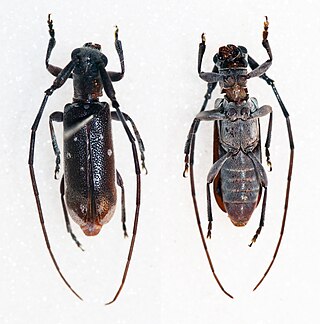Annona deceptrix is a species of plant in the Annonaceae family. It is endemic to Ecuador. Its natural habitat is subtropical or tropical moist lowland forests. It is threatened by habitat loss.

Squilla is a genus of mantis shrimp. It includes the following species:
Praenuculidae is an extinct family of prehistoric bivalves in the superfamily Nuculoidea. Praenuculidae species lived from the early Ordovician, Arenig stage through the Early Devonian Emsian stage. Praenuculidae fossils are found worldwide, present on every continent except Antarctica. Species in this family are thought to have been sessile, attached to the substrate in shallow infaunal marine water environments, where they formed shells of an aragonite composition. The family Praenuculidae was named by A. Lee McAlester in 1969.
Praenuculinae is an extinct subfamily of prehistoric bivalves in the family Praenuculidae. Praenuculinae species lived from the middle Ordovician through the late Devonian. Praenuculinae fossils are found in Europe, Africa, North America and South America, and species are thought to have been stationary attached to substrate in shallow infaunal marine water environments where they formed shells of an aragonite composition. The subfamily Praenuculinae was named by Teresa M. Sánchez in 1999.
Sphecosoma deceptrix is a moth in the subfamily Arctiinae. It was described by George Hampson in 1898. It is found in Guatemala and Panama.
Allotalanta deceptrix is a moth in the family Cosmopterigidae. It was described by Edward Meyrick in 1925. It is found in China (Liaoning).

Eunidiini is a tribe of longhorn beetles of the subfamily Lamiinae. It was described by Téocchi et al. in 2010.

Megachile deceptrix is a species of bee in the family Megachilidae. It was described by Smith in 1879.

Eunidia is a genus of longhorn beetles of the subfamily Lamiinae.

Speranza is a genus of moths in the family Geometridae erected by John Curtis in 1828.
Eunidia fallaciosa is a species of beetle in the family Cerambycidae. It was described by Stephan von Breuning in 1939. It is known from Somalia.
Eunidia flavoapicata is a species of beetle in the family Cerambycidae. It was described by Stephan von Breuning in 1939.

Eunidia tripunctata is a species of beetle in the family Cerambycidae. It was described by Per Olof Christopher Aurivillius in 1911.
Eunidia plagiata is a species of beetle in the family Cerambycidae. It was described by Charles Joseph Gahan in 1898. It is known from Chad, Kenya, Zimbabwe, Mozambique, Ethiopia, South Africa, Botswana, and Tanzania.
Eunidia subtesselata is a species of beetle in the family Cerambycidae. It was described by Charles Joseph Gahan in 1909. It is known from Kenya, Ethiopia, and Somalia.
Eunidia batesi is a species of beetle in the family Cerambycidae. It was described by Olliff in 1889.
Eunidia strigata is a species of beetle in the family Cerambycidae. It was described by Fahraeus in 1872. It contains the varietas Eunidia strigata var. damarensis.

Eunidia thomseni is a species of beetle in the family Cerambycidae. It was described by William Lucas Distant in 1898. It is known from Tanzania, Cameroon, Chad, Niger, Ethiopia, Senegal, Mozambique, Botswana, Namibia, Saudi Arabia, the Central African Republic, Somalia, Uganda, South Africa, Yemen, Kenya, and Zimbabwe.
Lebia deceptrix is a species of ground beetle in the family Carabidae. It lives in North America.
Speranza deceptrix is a species of moth in the family Geometridae first described by Harrison Gray Dyar Jr. in 1913. It is found in Central and North America.





